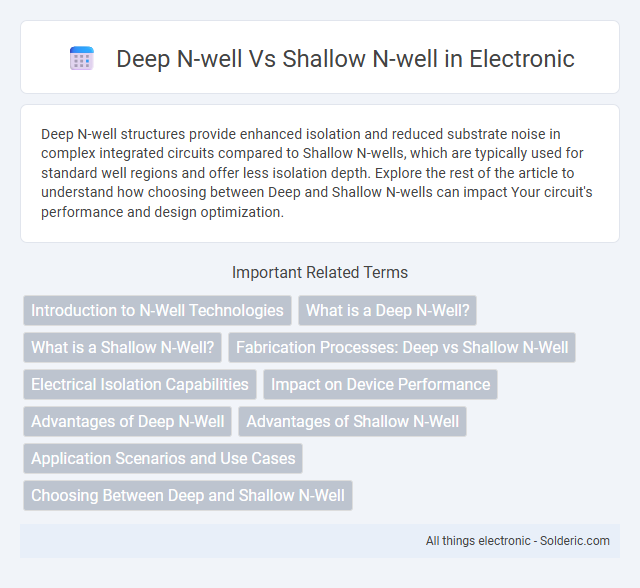Deep N-well structures provide enhanced isolation and reduced substrate noise in complex integrated circuits compared to Shallow N-wells, which are typically used for standard well regions and offer less isolation depth. Explore the rest of the article to understand how choosing between Deep and Shallow N-wells can impact Your circuit's performance and design optimization.
Comparison Table
| Feature | Deep N-well | Shallow N-well |
|---|---|---|
| Structure Depth | Extends deep into the substrate | Limited to a shallow region near the surface |
| Isolation Capability | Provides superior isolation between devices | Offers moderate isolation |
| Substrate Noise Suppression | Highly effective at reducing substrate noise | Less effective in noise suppression |
| Area Consumption | Consumes larger silicon area | Consumes less silicon area |
| Process Complexity | Requires advanced process steps | Relatively simple process integration |
| Applications | High-performance analog and mixed-signal circuits | Standard CMOS designs with moderate isolation needs |
Introduction to N-Well Technologies
Deep N-well and shallow N-well structures are essential components in CMOS technology, each offering distinct electrical isolation and substrate biasing capabilities. Deep N-well provides enhanced isolation for sensitive analog and mixed-signal circuits by embedding a deeper doped region, reducing latch-up susceptibility and noise coupling. Your circuit's performance and reliability can be significantly improved by selecting the appropriate N-well depth based on the design's isolation and substrate requirements.
What is a Deep N-Well?
A Deep N-Well is a specialized semiconductor structure used in CMOS technology to isolate sensitive analog or mixed-signal circuits from substrate noise by creating a deeper, heavily-doped N-type region beneath the surface. This deep pocket enables superior electrical isolation compared to a Shallow N-Well, enhancing your circuit's noise immunity and latch-up prevention. It is particularly beneficial in high-voltage or mixed-signal applications where substrate coupling and interference can degrade performance.
What is a Shallow N-Well?
A Shallow N-Well is a lightly doped n-type semiconductor region implanted close to the silicon surface, used to isolate p-type devices or transistors in CMOS technology. It provides reduced parasitic capacitance and improved latch-up immunity compared to Deep N-Well structures. Your integrated circuit design benefits from Shallow N-Well's enhanced performance in minimizing substrate noise and enabling compact layout.
Fabrication Processes: Deep vs Shallow N-Well
Deep N-well fabrication involves implanting dopants at greater depths using higher energy ion implantation, creating a thick, buried n-type region that enhances isolation and reduces substrate noise coupling. In contrast, shallow N-well processes use lower energy implants to form a thin, near-surface n-type layer, enabling faster transistor switching but offering less robust isolation. Your choice between deep and shallow N-well fabrication impacts device performance, isolation characteristics, and process complexity in integrated circuit design.
Electrical Isolation Capabilities
Deep N-well offers superior electrical isolation capabilities by effectively separating sensitive analog circuits from noisy digital substrates, reducing substrate noise coupling and latch-up risks. Shallow N-well provides basic isolation but is less effective in minimizing interference due to its limited depth and smaller volume of isolation. Your choice impacts circuit performance, especially in mixed-signal designs requiring robust noise immunity and stable operation.
Impact on Device Performance
Deep N-well structures improve isolation by reducing substrate noise and latch-up susceptibility, enhancing device stability and reliability in mixed-signal and RF circuits. Shallow N-well offers faster switching speeds and lower parasitic capacitance, benefiting high-speed digital applications but with less effective isolation. Optimizing the choice between Deep and Shallow N-well depends on the trade-off between noise immunity and switching performance in semiconductor device design.
Advantages of Deep N-Well
Deep N-Well technology provides superior isolation by offering enhanced substrate noise suppression and improved latch-up immunity compared to Shallow N-Well. It allows integration of high-voltage and mixed-signal circuits on the same chip, increasing design flexibility in advanced CMOS processes. The deeper well structure reduces parasitic capacitance and leakage currents, resulting in better device performance and power efficiency.
Advantages of Shallow N-Well
Shallow N-well technology offers significant advantages such as reduced parasitic capacitance and improved switching speeds, which enhance overall circuit performance. It provides better isolation in mixed-signal designs, minimizing substrate noise interference for highly sensitive analog components. You benefit from lower power consumption and increased integration density, making Shallow N-well ideal for advanced CMOS processes.
Application Scenarios and Use Cases
Deep N-well technology is primarily used in high-voltage and analog integrated circuits where isolation from substrate noise and latch-up prevention are critical, making it ideal for mixed-signal and RF applications. Shallow N-well is commonly applied in low-voltage, high-density digital circuits where space efficiency and reduced parasitic capacitance are prioritized, such as in advanced CMOS logic cells. The choice between Deep N-well and Shallow N-well depends on the trade-off between substrate isolation requirements and device scaling constraints.
Choosing Between Deep and Shallow N-Well
Choosing between deep and shallow N-wells depends on the required isolation and device performance in CMOS technology. Deep N-wells offer superior isolation for high-voltage applications and reduce substrate noise coupling, essential for mixed-signal and RF circuits. Shallow N-wells are preferred for lower voltage, high-density digital designs due to their reduced parasitic capacitance and smaller area consumption.
Deep N-well vs Shallow N-well Infographic

 solderic.com
solderic.com